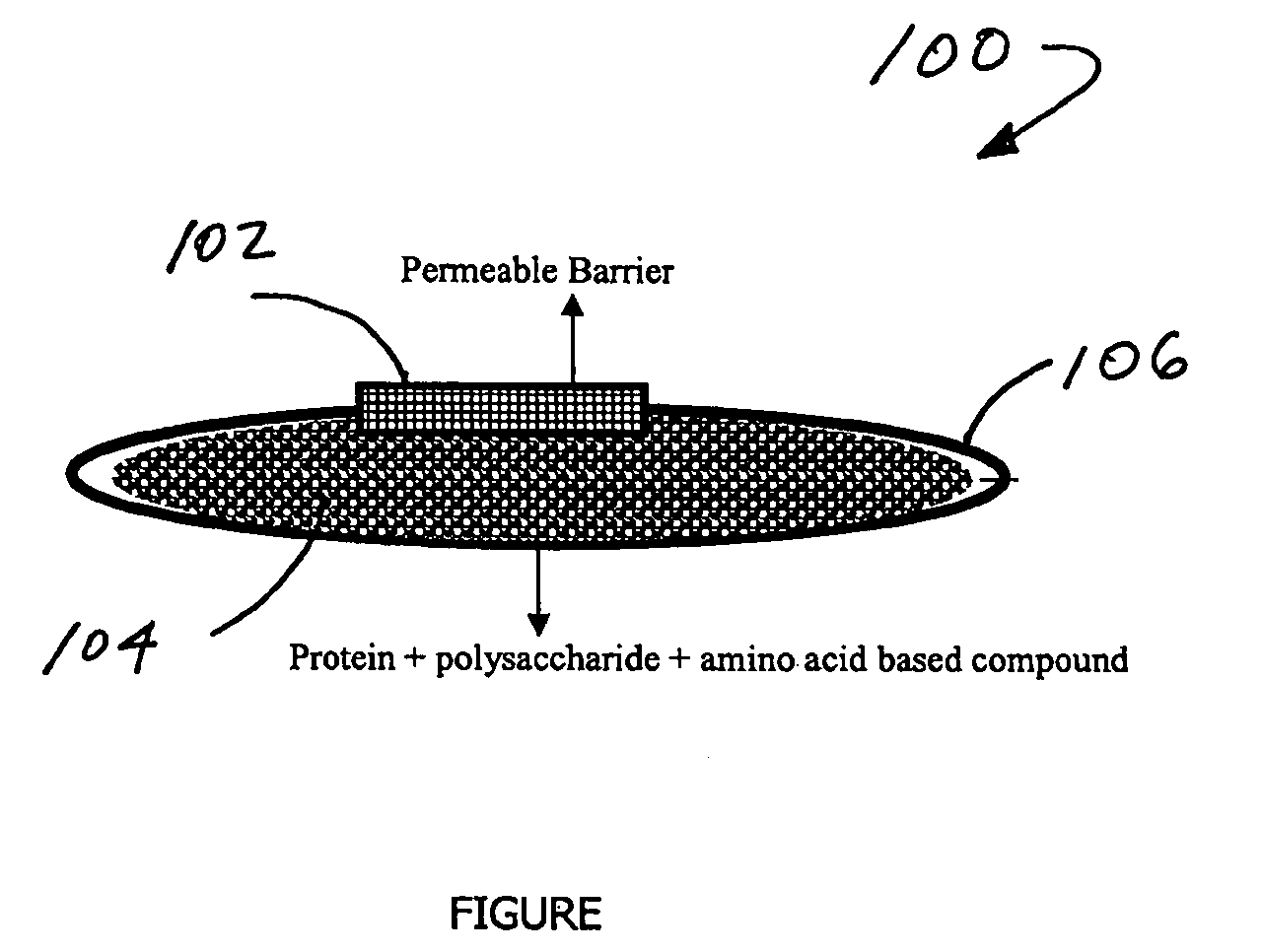Stabilization of biologically active proteins with mixtures of polysaccharides and amino acid based compounds
a technology of amino acid based compounds and proteins, which is applied in the field of heat stable aqueous solution or gel, can solve the problems of affecting both the conformational and chemical affecting the stability of a protein, and a protein's biological activity is particularly sensitive to certain environmental conditions, so as to prevent the swelling of the polysaccharide, uniform pore size, and reduced concentration
- Summary
- Abstract
- Description
- Claims
- Application Information
AI Technical Summary
Benefits of technology
Problems solved by technology
Method used
Image
Examples
example 1
[0055] This example illustrates source of materials used herein and any preliminary preparation of the materials. Recombinant human Interferon-γ was purchased from PBL Biomedical Laboratories and Shandong GeneLeuk Biopharmaceutical Co., Ltd. The protein from both suppliers showed a single protein band by gel electrophoresis at about 17,000 daltons and had the same anti-viral biological activity per mg of protein. Gum arabic, chymotrypsin, BSA, porcine gelatin A (300 bloom; 50,000-100,000 daltons), waxy corn starch, potato amylopectin, L-arginine (arg), L-lysine, poly-L-arginine 5,000-15,000 daltons (polyarg), human umbilical cord hyaluronic acid (MW about 4,000,000 daltons), Streptococcal hyaluronic acid (MW about 750,000 daltons), lactate dehydrogenase and glucose-6-phosphate dehydrogenase were obtained from Sigma. Eagle's Minimum Essential Medium (EMEM), Fetal Bovine Serum (FBS), and murine encephalomycarditis virus (EMCV) were obtained from the ATCC (American Type Culture Collect...
example 2
[0056] This example illustrates the preparation of gum arabic. Gum arabic (100 g) was dissolved in deionized water (1 L) and the pH of the solution was adjusted to 7.4 by the addition of 4 M sodium hydroxide. After the solution was centrifuged at 30,100×g for 10 minutes, the supernatant was filtered through an 11 μm nylon screen filter and then concentrated to approximately 300 mL on a Millipore Prep / Scale TFF-6 Tangential Flow Filter with a molecular weight cut off of 10,000 daltons. The volume of the concentrate was adjusted to 1 liter by the addition of deionized water and the process of concentration and reconstitution was repeated for a total of five cycles. After the final concentration, the 300 mL concentrate was transferred to a beaker. The filter apparatus was washed with about 100 mL aliquots of deionized water that were combined with the 300 mL concentrate until the volume of the concentrate was increase to 1 liter. The pH was then adjusted to 7.4 with 4 M sodium hydroxid...
example 3
[0057] This example illustrates the preparation of heated gum arabic. Gum arabic that was dialyzed and lyophilized (Example 1) was dissolved in deionized water as a 10% (w / w) solution. The sample was heated with vigorous magnetic stirring in a boiling water bath for 45 minutes. The solution was then cooled and the pH adjusted to 7.4 with 0.1 M sodium hydroxide. The sample was then lyophilized and the resulting solid was ground with a mortar and pestle and stored at 4° C.
[0058] Gum arabic tested positive for peroxidase enzymes before heating and tested negative for the enzymes after heat treatment, as determined by a calorimetric assay using 3,3′, 5,5′-Tetramethylbenzidine (TMB) liquid substrate for ELISA (Sigma Chemical Company).
PUM
| Property | Measurement | Unit |
|---|---|---|
| physiological temperature | aaaaa | aaaaa |
| temperature | aaaaa | aaaaa |
| temperatures | aaaaa | aaaaa |
Abstract
Description
Claims
Application Information
 Login to View More
Login to View More - R&D
- Intellectual Property
- Life Sciences
- Materials
- Tech Scout
- Unparalleled Data Quality
- Higher Quality Content
- 60% Fewer Hallucinations
Browse by: Latest US Patents, China's latest patents, Technical Efficacy Thesaurus, Application Domain, Technology Topic, Popular Technical Reports.
© 2025 PatSnap. All rights reserved.Legal|Privacy policy|Modern Slavery Act Transparency Statement|Sitemap|About US| Contact US: help@patsnap.com

